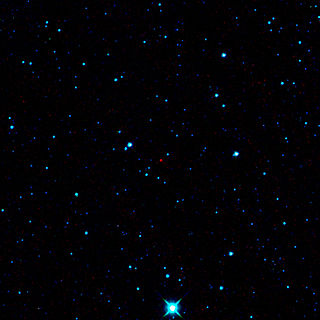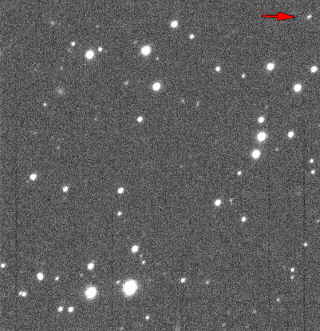Related Research Articles
(99907) 1989 VA is a very eccentric, stony asteroid and near-Earth object, approximately 1 kilometer in diameter. It was discovered on 2 November 1989, by American astronomer couple Carolyn and Eugene Shoemaker and Canadian astronomer David Levy at the Palomar Observatory on Mount Palomar, California.

(480808) 1994 XL1 is a sub-kilometer asteroid, classified as near-Earth object and potentially hazardous asteroid of the Aten group, approximately 200 meters (700 feet) in diameter. It was discovered on 6 December 1994, by Scottish–Australian astronomer Robert McNaught at Siding Spring Observatory in Australia. It was one of the first asteroids discovered to have a semi-major axis less than Venus.

3752 Camillo is an inclined contact-binary asteroid, classified as near-Earth object of the Apollo group, approximately 2.3 kilometers in diameter. It was discovered on 15 August 1985, by astronomers Eleanor Helin and Maria Barucci using a 0.9-metre (35 in) telescope at the CERGA Observatory in Caussols, France. Lightcurve studies by Petr Pravec in 1998 suggest that the assumed S-type asteroid has an elongated shape and a longer-than average rotation period of 38 hours.

(614599) 2010 AB78 is a dark asteroid on an eccentric orbit, classified as near-Earth object of the Amor group. It was first observed by the Wide-field Infrared Survey Explorer (WISE) on 12 January 2010. The asteroid measures approximately 1.7 kilometers in diameter and has a low albedo of 0.03, which is rather typical for carbonaceous asteroids.
(7025) 1993 QA is a sub-kilometer asteroid classified as near-Earth object of the Apollo and Amor group, respectively. It was discovered on 16 August 1993, by astronomers of the Spacewatch program at the Kitt Peak National Observatory near Tucson, Arizona, United States. The asteroid measures approximately half a kilometer in diameter and has a short rotation period of 2.5057 hours.
(242450) 2004 QY2 (prov. designation:2004 QY2) is an asteroid on an eccentric orbit, classified as near-Earth object and potentially hazardous asteroid of the Apollo group, approximately 3 kilometers (2 miles) in diameter. It was discovered on 20 August 2004 by the Siding Spring Survey at an apparent magnitude of 16.5 using the 0.5-metre (20 in) Uppsala Southern Schmidt Telescope. It is one of the largest potentially hazardous asteroids known to exist.

(511002) 2013 MZ5, provisional designation 2013 MZ5, is a sub-kilometer asteroid, classified as a near-Earth object of the Amor group, estimated to measure approximately 300 meters (1,000 feet) in diameter. It was discovered on 18 June 2013, by astronomers with the Pan-STARRS survey at Haleakala Observatory on the island of Maui, Hawaii, in the United States. It was the 10,000th near-Earth object ever discovered.

2005 HC4 is the asteroid with the smallest known perihelion of any known object orbiting the Sun (except sungrazing comets). Its extreme orbital eccentricity brings it to within 0.071 AU of the Sun (23% of Mercury's perihelion) and takes it as far as 3.562 AU from the Sun (well beyond the orbit of Mars). Due to its very small perihelion and comparably large aphelion, 2005 HC4 achieves the fastest speed of any known asteroid bound to the Solar System with a velocity of 157 km/s (565,000 km/h; 351,000 mi/h) at perihelion (there are comets, however, which obtain much higher speeds).
2008 FF5 is the asteroid with the second-smallest known perihelion of any known object orbiting the Sun. Its extreme orbital eccentricity brings it within 0.079 AU of the Sun (26% of Mercury's perihelion) and as far as 4.487 AU from the Sun (well beyond the orbit of Mars).
(374158) 2004 UL is a sub-kilometer asteroid on an outstandingly eccentric orbit, classified as near-Earth object and potentially hazardous asteroid of the Apollo group. The object is known for having the second-smallest perihelion of any known asteroid, after (137924) 2000 BD19.
(394130) 2006 HY51 is a near-Earth object of the Apollo asteroid group with a high orbital eccentricity, approximately 1.2 kilometers in diameter. It was discovered on 26 April 2006, by LINEAR at Lincoln Lab's ETS in Socorro, New Mexico, United States.
(391211) 2006 HZ51 is a bright, sub-kilometer asteroid on an eccentric orbit, classified as a near-Earth object and a potentially hazardous asteroid of the Amor group. It was discovered on 27 April 2006, by astronomers of the Catalina Sky Survey conducted at Mount Lemmon Observatory, Arizona, United States. During preliminary observations, it was thought to have a small chance of impacting Earth in 2008. The asteroid measures approximately half a kilometer in diameter and has an exceptionally high albedo.

(190166) 2005 UP156 is a stony asteroid and binary system, classified as near-Earth object of the Apollo group, approximately 1 kilometer in diameter. It was discovered on 31 October 2005, by astronomers of the Spacewatch survey at the Kitt Peak National Observatory in Arizona, United States. Its minor-planet moon with an orbital period of 40.25 hours was discovered in 2017.
(111253) 2001 XU10, provisional designation 2001 XU10, is an asteroid on an eccentric orbit, classified as near-Earth object and potentially hazardous asteroid of the Apollo group, approximately 3 kilometers in diameter. It was discovered on 9 December 2001, by astronomers of the LINEAR program at Lincoln Laboratory's Experimental Test Site near Socorro, New Mexico, in the United States. The asteroid is one of the largest potentially hazardous asteroids.

(505657) 2014 SR339, provisional designation 2014 SR339, is a dark and elongated asteroid, classified as near-Earth object and potentially hazardous asteroid of the Apollo group, approximately 970 meters (3,200 feet) in diameter. It was discovered on 30 September 2014, by NASA's Wide-field Infrared Survey Explorer telescope (WISE) in Earth's orbit. Closely observed at Goldstone and Arecibo in February 2018, it has a rotation period of 8.7 hours.

2018 CC is a micro-asteroid, classified as a near-Earth object of the Apollo group, approximately 20 meters (70 ft) in diameter. Its official first observation was made by the Catalina Sky Survey at Mount Lemmon Observatory, Arizona, United States, on 4 February 2018. Two days later, the asteroid crossed the orbit of the Moon and made a very close approach to Earth.
(85182) 1991 AQ, provisional designation 1991 AQ, is a stony asteroid on a highly eccentric orbit, classified as near-Earth object and potentially hazardous asteroid of the Apollo group, approximately 1.1 kilometers in diameter. It was discovered on 14 January 1991, by American astronomer Eleanor Helin at the Palomar Observatory in California. Based on its brightness variation of 0.69 magnitude, this Q-type asteroid is likely elongated. It belongs to the small group of potentially hazardous asteroids larger than one kilometer.
(385343) 2002 LV, provisional designation 2002 LV, is a stony asteroid on a highly eccentric orbit, classified as near-Earth object and potentially hazardous asteroid of the Apollo group, approximately 1.5 kilometers in diameter. It was discovered on 1 June 2002, by astronomers with the Lincoln Near-Earth Asteroid Research at the Lincoln Laboratory's Experimental Test Site near Socorro, New Mexico, in the United States. The Sr-type asteroid has a rotation period of 6.2 hours and is likely elongated.
(154276) 2002 SY50, provisional designation 2002 SY50, is a stony asteroid on a highly eccentric orbit, classified as near-Earth object and potentially hazardous asteroid of the Apollo group, approximately 1.1 kilometers (0.7 miles) in diameter. It was discovered on 30 September 2002, by astronomers with the Lincoln Near-Earth Asteroid Research at the Lincoln Laboratory's Experimental Test Site near Socorro, New Mexico, in the United States. The K-type asteroid has a rotation period of 4.8 hours. It will make a close encounter with Earth on 30 October 2071.

2019 AQ3 is an inclined near-Earth object of the small Atira group from the innermost region of the Solar System, estimated to measure 1.4 kilometers (0.9 miles) in diameter. Among the hundreds of thousands known asteroids, 2019 AQ3's orbit was thought to have likely the smallest semi-major axis (0.589 AU) and aphelion (0.77 AU), that is, the orbit's average distance and farthest point from the Sun, respectively. The object was first observed on 4 January 2019, by astronomers at Palomar's Zwicky Transient Facility in California, with recovered images dating back to 2015.
References
- 1 2 3 4 5 6 7 "JPL Small-Body Database Browser: 386454 (2008 XM)" (2014-01-29 last obs.). Jet Propulsion Laboratory . Retrieved 2 June 2017.
- 1 2 3 "386454 (2008 XM)". Minor Planet Center. Retrieved 26 October 2016.
- 1 2 3 Mainzer, A.; Bauer, J.; Grav, T.; Masiero, J.; Cutri, R. M.; Wright, E.; et al. (April 2014). "The Population of Tiny Near-Earth Objects Observed by NEOWISE". The Astrophysical Journal. 784 (2): 7. arXiv: 1310.2980 . Bibcode:2014ApJ...784..110M. doi:10.1088/0004-637X/784/2/110 . Retrieved 26 October 2016.